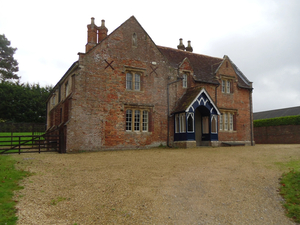The Heritage Articles - Smuggling in West Parley

A rapid increase in customs and excise duty in the 18th and early 19th centuries led to a huge rise in smuggling across the country to avoid paying these taxes. Increasing quantities of goods were illegally imported and due to the easy gains and relatively low risks, the trade involved much of the coastal and rural population.
The trade started in Kent and Sussex but following stricter control by customs men it moved much further west to the more open coastline and isolated landing spots where a sparse and supportive population made the trade more attractive. The Dorset coast in Georgian times was a smuggling hotspot. Smuggling was deemed to be an honourable trade and the problem was so rampant due to the shortage of customs men that sometimes the Dragoons, a local militia, were deployed to stop the trade.
Many types of goods were smuggled from tea, coffee, beer, wine, tobacco and spirits to heavily taxed luxury good such as silks and lace. Goods were transported in carts, on ponies and even carried by men.
Poole harbour, the chines on the Bournemouth coast and around Christchurch, particularly Mudeford beach, were the main areas locally for illegal goods to be brought ashore. From the chines goods were brought across the isolated heathland to Kinson then crossed the Stour at Longham then on to either Wimborne or across the top of Parley Common via Palmers Ford on the way north east.
From Christchurch goods could be moved up the north side of the Stour past Hurn and West Parley to Wimborne and on to Cranborne as well as up the Avon valley.
The network of small paths, large wooded areas and sparse local population on the heathland from the coast to the Stour valley made evasion easy for smugglers and there were a number of places where goods could be hidden.
By far the most important local smuggler was Isaac Gulliver who organised a local gang of some 50 men to bring in huge volumes of goods across the whole of the Dorset coast. He traded as a wine merchant and inn keeper as a cover for smuggling and the financial gains allowed him to buy many houses across the area, including Hillamsland on Christchurch Road, now part of the Dudsbury Golf Club, that he lived in from 1791 to 1793. There are large cellars beneath the house that could have stored large quantities of illegal goods.
He had previously lived at the White Hart in Longham in the 1770s, in West Moors and also lived in a number of large houses in Kinson.
His smuggling activities allowed him to buy a large amount of land and buildings in Kinson and the village became a centre for smuggling, including the small church of St Andrews in Millhams Lane. Some of Gulliver’s farmhouses were raided by the customs men, as was the Gulliver inn in Kinson, but there was never enough evidence to convict him. These raids, together with the bridge crossing of the Stour at Longham being an obvious place for the customs men to keep an eye on, may have encouraged transfer of smaller quantities of goods by fording the Stour to get goods north to West Parley and beyond.
In summer the river can be shallow and a crossing by horse and cart as well as horses is easy. Crossing by boat was also simple. A local map of 1860 shows ‘Dudsbury Shallows’ marked on the Stour close to the Dudsbury hill fort and in older maps Ridgeway, formerly known as Dudsbury Lane, is shown as a track leading directly from the level ground on the edge of the Stour north to Christchurch Road.
There are no houses or farms shown here on the old maps so the only reason for the track is to access the river with goods crossing from Kinson at this point or coming across at Dudsbury Shallows further west and being brought along the edge of the river beneath the hill fort. The track up to Ridgeway is a steep and well defined path and is lined with ancient oak trees proving its age. It is easy to imagine a group of horses and riders quietly coming up the track in the darkness.
The other regular crossing in West Parley was at Riddles Ford, opposite Redhill, at the most southerly part of the parish. This is an ancient river crossing known to have dated from prehistoric times. The route from the river went both directly north along the Parley / Hurn parish boundary to Palmers Ford and on a track that still exists northwest along the bank of the river to Church Lane then north over Parley Common.